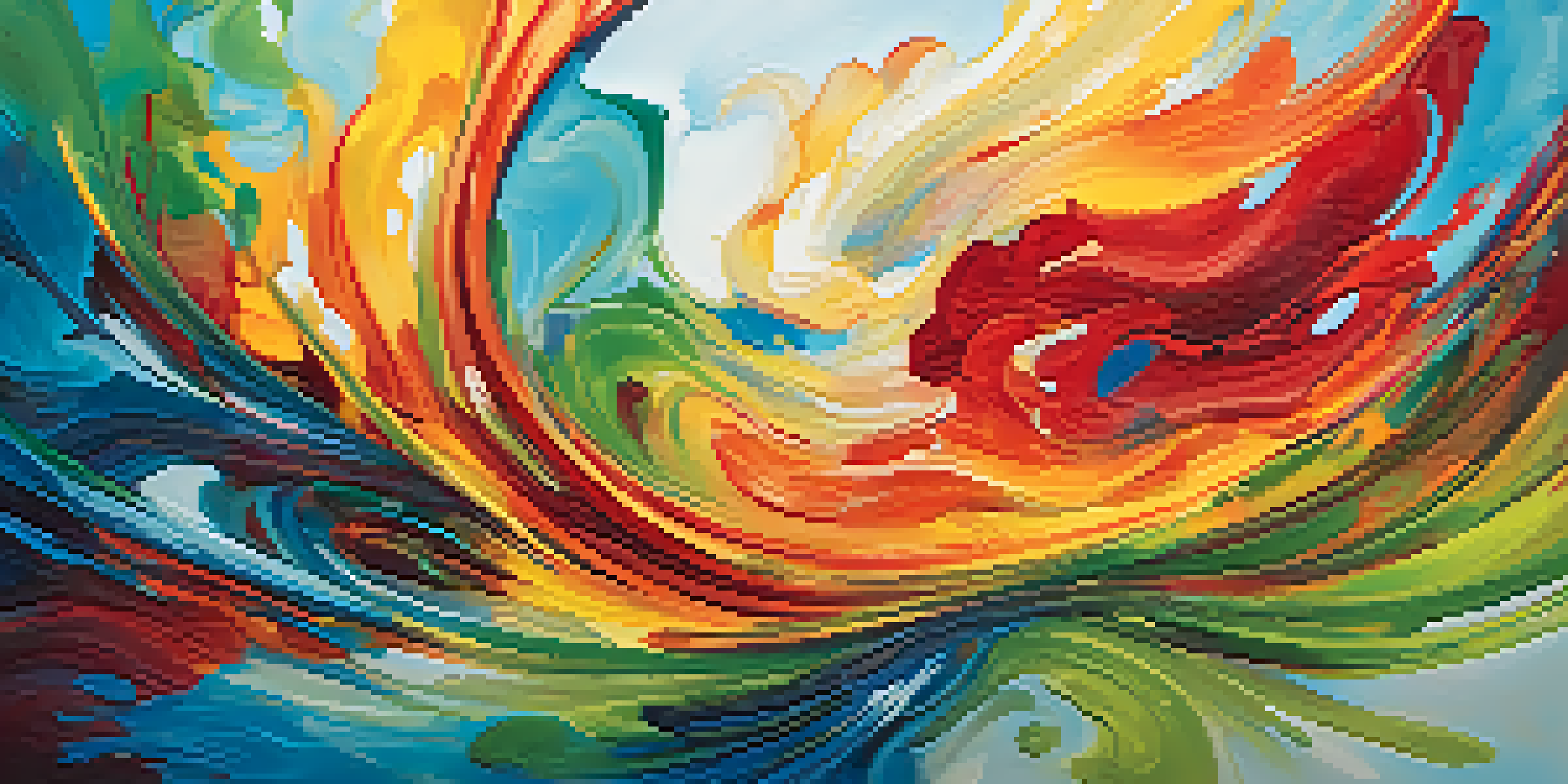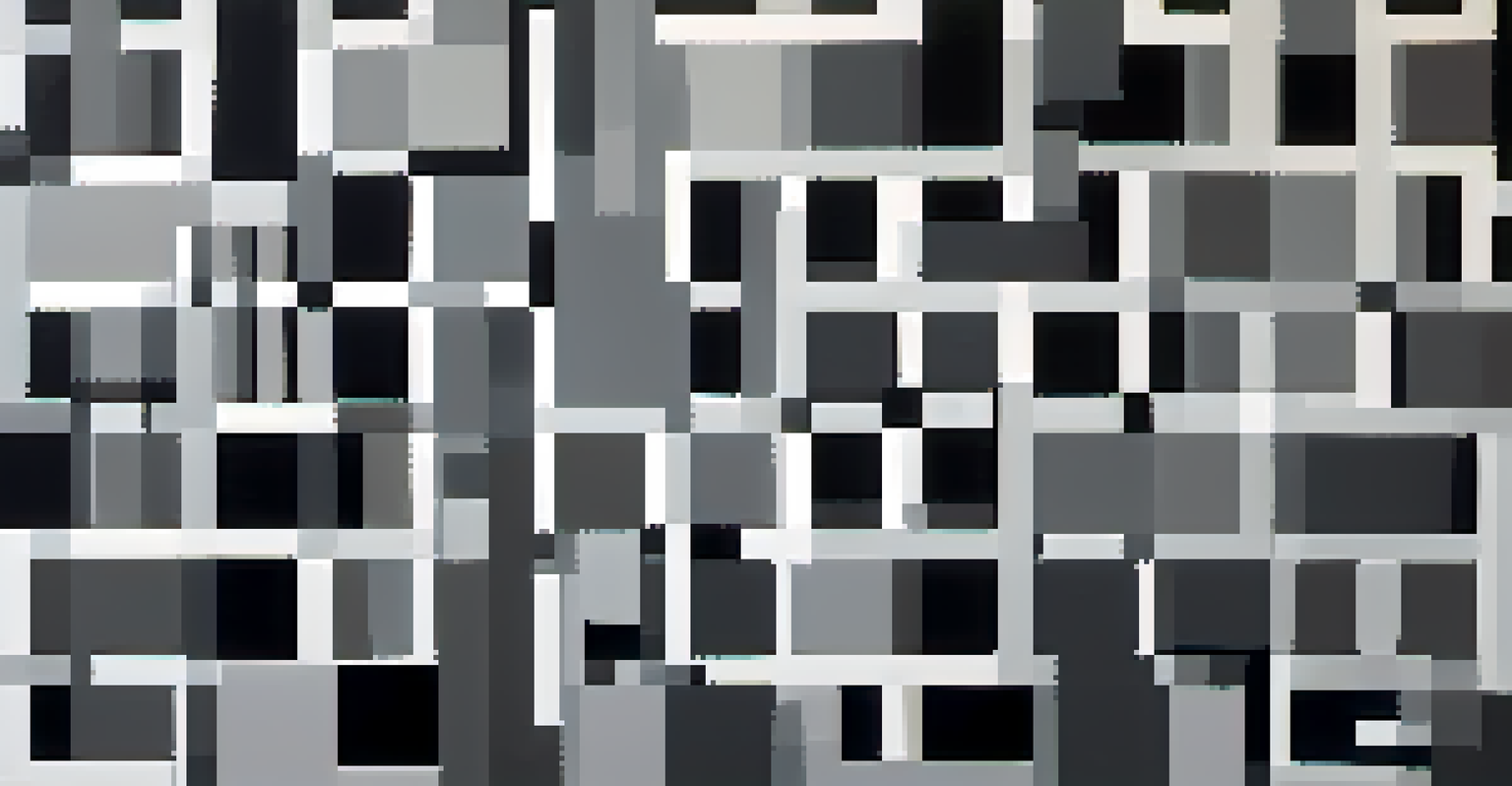Exploring Abstract Art: Cultural Interpretations and Meanings

Understanding the Basics of Abstract Art
Abstract art is a style that moves away from traditional representation. Instead of depicting objects as they are, it focuses on colors, shapes, and forms that evoke emotions and ideas. This can be a bit confusing at first, especially for those used to realism in art.
Abstract art allows you to see the world through the eyes of the artist, revealing their emotions and thoughts in a unique way.
The beauty of abstract art lies in its subjectivity; each viewer may interpret a piece differently based on personal experiences. For example, a chaotic swirl of colors might evoke feelings of joy for one person, while another might see it as chaotic or stressful. This aspect makes abstract art unique and engaging.
As you explore abstract art, it's essential to keep an open mind. Try to connect with the artwork on an emotional level rather than seeking a literal interpretation. This shift in perspective can unlock a deeper appreciation for the artist's intent and the cultural nuances embedded within the piece.
The Historical Context of Abstract Art
Abstract art emerged in the late 19th and early 20th centuries as artists sought to break away from conventional forms. Influenced by movements like Impressionism and Cubism, artists began to experiment with abstraction, challenging the norms of representation in art. This revolutionary shift mirrored the societal changes of the time, including advancements in technology and shifts in philosophical thought.

Pioneers like Wassily Kandinsky and Piet Mondrian were instrumental in this movement. Kandinsky, for instance, believed that colors and shapes could express feelings and spirituality without the need for recognizable subjects. His works often reflect a synesthetic experience, where colors evoke sounds and emotions, illustrating the profound connection between art and personal experience.
Abstract Art is Emotionally Driven
The emotional impact of abstract art invites viewers to connect with the artwork on a deeper level, often provoking introspection.
Understanding the historical roots of abstract art helps us appreciate its evolution and significance. As society continues to change, so too does the interpretation of abstract art, making it a dynamic reflection of cultural shifts and collective consciousness.
Cultural Interpretations of Abstract Art
Different cultures bring diverse perspectives to abstract art, shaping how it is created and perceived. For instance, African and Indigenous artists often incorporate spiritual and communal themes into their abstract works, reflecting the importance of community and tradition. This cultural lens offers a rich tapestry of meanings that can vary significantly from Western interpretations.
The essence of abstract art is to create a dialogue between the artist and the viewer, transcending literal representation.
In contrast, Western abstract art often emphasizes individualism and personal expression. Artists like Jackson Pollock embodied this spirit, using techniques like drip painting to showcase spontaneity and emotion. This divergence in cultural values highlights how abstract art serves as a mirror to societal beliefs and practices, inviting us to explore deeper meanings.
By engaging with abstract art from multiple cultural viewpoints, we can gain a more holistic understanding of its significance. This exploration encourages us to celebrate diversity and acknowledge the myriad ways that art can communicate complex ideas beyond words.
The Role of Emotion in Abstract Art
Emotion plays a central role in the creation and interpretation of abstract art. Artists often use color theory and composition to convey feelings, tapping into the viewer's emotional responses. For example, warm colors like red and orange can evoke feelings of warmth or passion, while cool colors like blue and green may inspire calmness or serenity.
Consider how a piece of abstract art, filled with frenetic lines and bold colors, might make you feel anxious or energized. This emotional impact is intentional, as artists aim to elicit specific feelings through their work. In this way, abstract art becomes a dialogue between the artist and the viewer, often provoking introspection.
Cultural Perspectives Shape Art
Different cultural backgrounds influence the creation and interpretation of abstract art, highlighting diverse themes and values.
By understanding the emotional undercurrents in abstract art, we can enhance our appreciation for the medium. This awareness allows us to engage more deeply with the artwork, fostering a personal connection that transcends the visual elements.
Abstract Art and Its Connection to Modern Society
In today’s fast-paced world, abstract art continues to resonate with contemporary audiences. Its ability to encapsulate complex emotions and ideas in a non-representational form makes it particularly relevant in a society that often struggles to articulate its feelings. Abstract art invites us to pause and reflect, providing a much-needed escape from everyday chaos.
Moreover, as technology evolves, so does the medium of abstract art. Digital art forms, such as generative art, push the boundaries of traditional abstraction, allowing for new interpretations and experiences. This intersection of technology and art not only broadens the scope of creativity but also democratizes access to art-making.
As we navigate modern society, abstract art serves as a powerful tool for self-expression and cultural commentary. It challenges us to confront our emotions and societal issues, making it an essential part of contemporary discourse.
The Process of Creating Abstract Art
Creating abstract art can be both liberating and intimidating. Unlike traditional forms of art that often require specific techniques or skills, abstract art encourages experimentation and freedom of expression. Artists may start with a concept or emotion in mind but often let the process guide them, allowing spontaneity to shape the final piece.
Many artists find inspiration in their surroundings, personal experiences, or even their emotional state at the moment of creation. This organic approach can result in unexpected outcomes, making each piece unique. For instance, an artist might begin with a specific color palette that reflects their mood, only to have the composition evolve in surprising ways as they work.
Abstract Art Evolves with Society
As society changes, abstract art continues to adapt, reflecting contemporary issues and fostering a dialogue about emotions and experiences.
Embracing the process is key to creating meaningful abstract art. It encourages artists to let go of perfectionism and instead focus on the journey of creation, which can be just as important as the finished product.
The Future of Abstract Art and Cultural Significance
Looking ahead, abstract art will undoubtedly continue to evolve alongside cultural shifts and technological advancements. As artists explore new mediums and concepts, the dialogue around abstract art will expand, inviting fresh interpretations and perspectives. This evolution underscores the dynamic nature of art as a reflection of society.
Moreover, as global connectivity increases, artists from diverse backgrounds can share their unique approaches to abstraction, enriching the art world. This cross-cultural exchange fosters collaboration and innovation, leading to new forms that challenge traditional boundaries.

Ultimately, the future of abstract art lies in its ability to adapt and resonate with audiences around the world. By embracing its cultural significance and fostering inclusivity, abstract art can continue to inspire and provoke thought, bridging gaps and celebrating the richness of human experience.